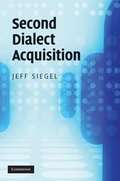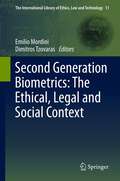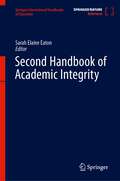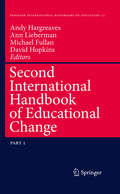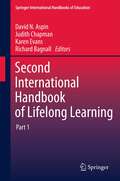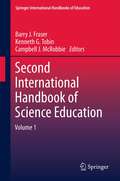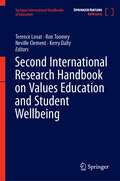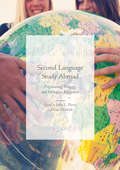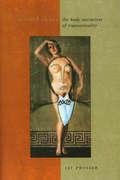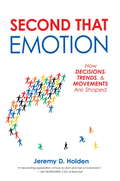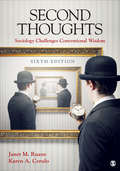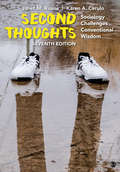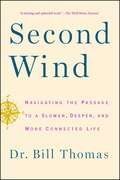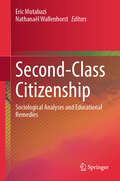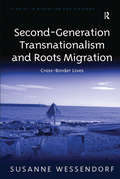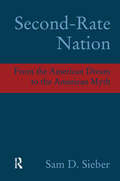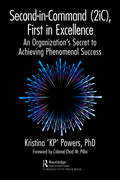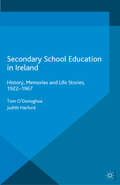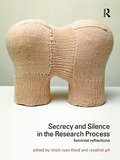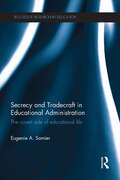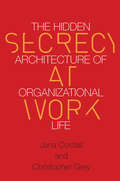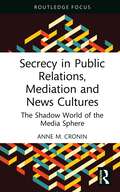- Table View
- List View
Second Dialect Acquisition
by Jeff SiegelWhat is involved in acquiring a new dialect - for example, when Canadian English speakers move to Australia or African American English-speaking children go to school? How is such learning different from second language acquisition (SLA), and why is it in some ways more difficult? These are some of the questions Jeff Siegel examines in this book, the first to focus specifically on second dialect acquisition (SDA). Siegel surveys a wide range of studies that throw light on SDA. These concern dialects of English as well as those of other languages, including Dutch, German, Greek, Norwegian, Portuguese and Spanish. He also describes the individual and linguistic factors that affect SDA, such as age, social identity and language complexity. The book discusses problems faced by students who have to acquire the standard dialect without any special teaching, and presents some educational approaches that have been successful in promoting SDA in the classroom.
Second Generation Biometrics: The Ethical, Legal and Social Context
by Dimitros Tzovaras Emilio MordiniWhile a sharp debate is emerging about whether conventional biometric technology offers society any significant advantages over other forms of identification, and whether it constitutes a threat to privacy, technology is rapidly progressing. Politicians and the public are still discussing fingerprinting and iris scan, while scientists and engineers are already testing futuristic solutions. Second generation biometrics - which include multimodal biometrics, behavioural biometrics, dynamic face recognition, EEG and ECG biometrics, remote iris recognition, and other, still more astonishing, applications - is a reality which promises to overturn any current ethical standard about human identification. Robots which recognise their masters, CCTV which detects intentions, voice responders which analyse emotions: these are only a few applications in progress to be developed. This book is the first ever published on ethical, social and privacy implications of second generation biometrics. Authors include both distinguished scientists in the biometric field and prominent ethical, privacy and social scholars. This makes this book an invaluable tool for policy makers, technologists, social scientists, privacy authorities involved in biometric policy setting. Moreover it is a precious instrument to update scholars from different disciplines who are interested in biometrics and its wider social, ethical and political implications.
Second Handbook of Academic Integrity (Springer International Handbooks of Education)
by Sarah Elaine EatonThe book brings together diverse views from around the world and provides a comprehensive overview of academic integrity and how to create the ethical academy. At the same time, the Handbook does not shy away from some of the vigorous debates in the field such as the causes of academic integrity breaches. There has been an explosion of interest in academic integrity in the last 20-30 years. New technologies that have made it easier than ever for students to ‘cut and paste’, coupled with global media scandals of high profile researchers behaving badly, have resulted in the perception that plagiarism is ‘on the rise’. This, in combination with the massification and commercialisation of higher education, has resulted in a burgeoning interest in the importance of academic integrity, how to safeguard it and how to address breaches appropriately. What may have seemed like a relatively easy topic to address – students copying sources without attribution – has in fact, turned out to be a complex, interdisciplinary field of research requiring contributions from linguists, psychologists, social scientists, anthropologists, teaching and learning specialists, mathematicians, accountants, medical doctors, lawyers and philosophers, to name just a few.Because of this broad interest and input, this handbook serves as the single authoritative reference work which brings together the vast, growing, interdisciplinary and at times contradictory body of literature. For both established researchers/practitioners and those new to the field, this Handbook provides a one-stop-shop as well as a launching pad for new explorations and discussions.
Second International Handbook of Educational Change
by David Hopkins Andy Hargreaves Michael Fullan Ann LiebermanThe two volumes of the second edition of the International Handbook of Educational Change comprise a totally new, and updated collection of the most critical and cutting-edge ideas in educational change. Written by the most influential thinkers in the field, these volumes cover educational change at both the theoretical and practical levels. The updated handbook remains connected to the classical concerns of the field, such as educational innovation, reform, and change management, and also offers new insights into educational change that have been brought about by social change and shifting contexts of educational reform. Like the first best selling Handbook, this one will also undoubtedly become an essential resource for people involved in all spheres of education, from classroom teachers, teacher leaders and administrators to educational researchers, curriculum developers, and university professors. No other work provides such a wide-ranging and comprehensive examination of the field of educational change.
Second International Handbook of Lifelong Learning
by Karen Evans Richard Bagnall David N. Aspin Judith ChapmanThe second edition of the International Handbook of Lifelong Learning is extensive, innovative, and international in scope, remit and vision, inviting its readers to engage in a critical re-appraisal of the theme of "lifelong learning". It is a thorough-going, rigorous and scholarly work, with profound and wide-ranging implications for the future of educating institutions and agencies of all kinds in the conception, planning and delivery of lifelong learning initiatives. Lifelong learning requires a wholly new philosophy of learning, education and training, one that aims to facilitate a coherent set of links and pathways between work, school and education, and recognises the necessity for government to give incentives to industry and their employees so they can truly "invest" in lifelong learning. It is also a concept that is premised on the understanding of a learning society in which everyone, independent of race, creed or gender, is entitled to quality learning that is truly excellent. This book recognises the need for profound changes in education and for goals that are critically important to education, economic advancement, and social involvement. To those concerned about the future of our society, our economy and educational provision, this book provides a richly illuminating basis for powerful debate. Drawing extensively on policy analyses, conceptual thinking and examples of informed and world-standard practice in lifelong learning endeavours in the field, both editors and authors seek to focus readers' attention on the many issues and decisions that must be addressed if lifelong learning is to become a reality for us all.
Second International Handbook of Science Education
by Campbell J. Mcrobbie Barry J. Fraser Kenneth TobinThe International Handbook of Science Education is a two volume edition pertaining to the most significant issues in science education. It is a follow-up to the first Handbook, published in 1998, which is seen as the most authoritative resource ever produced in science education. The chapters in this edition are reviews of research in science education and retain the strong international flavor of the project. It covers the diverse theories and methods that have been a foundation for science education and continue to characterize this field. Each section contains a lead chapter that provides an overview and synthesis of the field and related chapters that provide a narrower focus on research and current thinking on the key issues in that field. Leading researchers from around the world have participated as authors and consultants to produce a resource that is comprehensive, detailed and up to date. The chapters provide the most recent and advanced thinking in science education making the Handbook again the most authoritative resource in science education.
Second International Research Handbook on Values Education and Student Wellbeing (Springer International Handbooks of Education)
by Terence Lovat Kerry Dally Neville Clement Ron ToomeyThis collection applies the principles underlying values education to addressing the many social and learning challenges that impinge on education today . Insights in the fields of social and emotional learning, student wellbeing, and, increasingly, educational neuroscience have demonstrated that values education represents an efficacious pedagogy with holistic effects on students across a range of measures, including social, emotional, and intellectual outcomes. With schools in the 21st century confronting issues such as gender identity, stemming radicalism, mental health, equity for disadvantaged groups, bullying, respect, and the meaning of consent, values education offers a way of teaching and learning that integrates and enhances student’s affective and cognitive functioning. The earlier edition of this book has become a standard reference for scholars and practitioners in the fields of values education, moral education, and character education. Its citation rates, reads and downloads have been consistently and enduringly high, as have those of its companion text, Values Pedagogy and Student Achievement. A decade on, the main purpose of the revised edition is to update and incorporate new research and practice relevant to values education. Recent insights in the fields of neuroscience and social and emotional learning and their implications for education and student wellbeing are more overt than they were when the first edition was being compiled. Additionally, advanced thinking in the field of epistemology, how humans come to know and therefore learn, has also sharpened, especially through the later writings of prominent scholars like Jurgen Habermas. The revised edition has preserved the essential spirit and thrust of the original edition while making space for some of these new insights about the potential of values education to establish optimal and harmonious learning and social environments for both students and teachers.
Second Language Study Abroad: Programming, Pedagogy, And Participant Engagement
by John L. Plews Kim MisfeldtThis edited volume explores studying second languages abroad by critically and constructively reviewing established programming, providing theoretical and research-informed support for pedagogical and curriculum interventions, and analysing participant experiences. Over 12 chapters the contributors examine key issues including teaching approaches, learning activities, and relationships in the target language and culture. This book is most distinct in its attempt to promote diversity in approaches and experiences while drawing the common thread of learner- and learning-centredness through each chapter. The contributing authors represent a wide range of academies and discuss study abroad programs and participants in diverse cultural and geographic regions. The book’s international scope will acquaint educators and researchers with a broad variety of practices, stimulate comparison across contexts, and promote innovation.
Second Skins: The Body Narratives of Transsexuality (Gender and Culture Series)
by Jay ProsserDo we need bodies for sex? Is gender in the head or in the body? In Second Skins Jay Prosser reveals the powerful drive that leads men and women literally to shed their skins and--in flesh and head--to cross the boundary of sex. Telling their story is not merely an act that comes after the fact, it's a force of its own that makes it impossible to forget that stories of identity inhabit autobiographical bodies.In this stunning first extensive study of transsexual autobiography, Jay Prosser examines the exchanges between body and narrative that constitute the phenomenon of transsexuality. Showing how transsexuality's somatic transitions are spurred and enabled by the formal transitions of narrative, Prosser uncovers a narrative tradition for transsexual bodies. Sex change is a plot--and thus appropriately transsexuals make for adept and absorbing authors. In reading the transssexual plot through transsexuals' own recounting, Prosser not only gives us a new and more accurate rendition of transsexuality. His book suggests transsexuality, with its extraordinary conjunctions of body and narrative, as an identity story that transitions across the body/language divide that currently stalls poststucturalist thought.The form and approach of Second Skins works to cross other important and parallel divides. In addition toanalyzing transsexual textual accounts, the book includes some 30 photographic portraits of transsexuals--poignant attempts by transsexuals to present themselves unmediated to the world except by the camera. And the author does not shy from exposure himself. Interjecting the personal into his theoretical discussion and close textual work throughout the book, Prosser reads and writes his own body, his purpose in that stylistic crossing to stake out transsexuality--and hence this very book--as his own body's narrative.
Second That Emotion
by Jeremy D. HoldenFor businesspeople who want to see their company or brand break through, this book is both essential and entertaining reading. For the rest of us, the author provides a window into our decision-making processes, and how emotion-based illogical leaps drive our support for movements, whether they are political, commercial, or related to popular culture. Why do more than 30 percent of Americans believe President Obama is a Muslim? Why do most fans who supported Dove®'s "campaign for real beauty" feel comfortable ignoring the fact that the brand's parent company, Unilever, was also behind the Axe® campaign, a brand that has blatantly stereotyped women? Why is Yoko Ono still held responsible for the breakup of the Beatles? These and other random, yet related, questions are explained in here. An advertising and communications expert traces the fascinating process whereby a passion for an idea, a politician, a celebrity, or a brand gives rise to a set of illogical beliefs that becomes the basis for a powerful movement. Conventional wisdom has it that spin doctors and Madison Avenue are responsible for manipulating our thoughts, causing us to endorse ideas or buy products that we would otherwise reject outright. Holden shows that while advertising and propaganda can provide a spark and social media provides the kindling, individuals create consumer, political, and cultural trends based, more often than not, on thinking that they know logically to be flawed.
Second Thoughts: Sociology Challenges Conventional Wisdom
by Dr Janet M. Ruane Karen A. CeruloCo-authored by Karen A. Cerulo, the Eastern Sociological Society’s Robin L. Williams Lecturer for 2013-2014 Do birds of a feather flock together or do opposites attract? Is honesty the best policy? Are children our most precious commodity? Is education the great equalizer? Adages like these shape our social life. This Sixth Edition of Second Thoughts reviews several popular beliefs and notes how these conventional wisdoms cannot be taken at face value, but instead require careful second thoughts. This unique text encourages students to step back and sharpen their analytic focus with 25 essays that use social research to expose the gray areas of commonly held beliefs, revealing the complexity of social reality and sharpening students’ sociological vision.
Second Thoughts: Sociology Challenges Conventional Wisdom
by Dr Janet M. Ruane Karen A. CeruloCo-authored by Karen A. Cerulo, the Eastern Sociological Society’s Robin L. Williams Lecturer for 2013-2014 Do birds of a feather flock together or do opposites attract? Is honesty the best policy? Are children our most precious commodity? Is education the great equalizer? Adages like these shape our social life. This Sixth Edition of Second Thoughts reviews several popular beliefs and notes how these conventional wisdoms cannot be taken at face value, but instead require careful second thoughts. This unique text encourages students to step back and sharpen their analytic focus with 25 essays that use social research to expose the gray areas of commonly held beliefs, revealing the complexity of social reality and sharpening students’ sociological vision.
Second Thoughts: Sociology Challenges Conventional Wisdom
by Janet M. Ruane Karen A. CeruloIntroducing students to core sociological concepts by debunking popular misconceptions Is it true that "numbers don′t lie?" Is America "the land of equal opportunity?" Is marriage a "dying institution?" Oft-repeated adages like these shape our beliefs about the society we live in. Each essay in Second Thoughts reviews a conventional wisdom familiar to both instructors and students. The authors introduce relevant sociological concepts and theories in order to explain, qualify, and sometimes debunk that conventional wisdom. This unique text encourages students to step back and sharpen their analytic focus. 23 engaging essays reveal the complexity of social reality and demonstrate the role of sociology in everyday life.
Second Thoughts: Sociology Challenges Conventional Wisdom
by Janet M. Ruane Karen A. CeruloIntroducing students to core sociological concepts by debunking popular misconceptions Is it true that "numbers don′t lie?" Is America "the land of equal opportunity?" Is marriage a "dying institution?" Oft-repeated adages like these shape our beliefs about the society we live in. Each essay in Second Thoughts reviews a conventional wisdom familiar to both instructors and students. The authors introduce relevant sociological concepts and theories in order to explain, qualify, and sometimes debunk that conventional wisdom. This unique text encourages students to step back and sharpen their analytic focus. 23 engaging essays reveal the complexity of social reality and demonstrate the role of sociology in everyday life.
Second Wind
by Dr Bill ThomasHow do you know that you are outgrowing adulthood? When you begin to feel that the life you have been living is out of balance; when the need to perform, to hurry, and to acquire is no longer compelling. It's like the moment when your favorite tennis shoes start to give you blisters. The way you've been living your adult life doesn't fulfill you anymore. Dr. Bill Thomas, one of the most innovative thinkers in medicine, explains that a new life phase is beginning to emerge within our society. When the Baby Boom generation came of age in the 1960s and 1970s, they jump-started a cultural revolution that shaped today's society. Now, many feel they are living a life of frenzied disharmony. This out-of-balance feeling is a signal that you are ready for your second coming of age, your life beyond adulthood. Second Wind illuminates how to recognize and navigate the most challenging and fulfilling developmental stage of life. Life can and should be reimagined. New ways of living and working are waiting to be discovered on the far side of adulthood. Dr. Thomas treats the Baby Boom generation as he would one of his patients, sympathetically exploring its history before recommending a path toward a life rich with developmental opportunities. Predicting that Boomers will choose the path of the Denialist, the Realist, or the Enthusiast, he discusses the behaviors and attitudes that will provide new and more nourishing fuel for the rest of life's journey: hope and a renewed sense of all that is possible.
Second-Class Citizenship: Sociological Analyses and Educational Remedies
by Nathanaël Wallenhorst Eric MutabaziA number of features of the contemporary period are preventing people from exercising their citizenship: the acceleration and permanent change in the conditions shaping habitability of planet Earth, the digital and techno-scientific revolution, the rise of religious and political radicalisation, the explosion of social inequalities, the hegemony of the economic drive to maximise individual interests, etc. For many individuals, citizenship appears to be prevented at the first hurdle. What is more, though officially or legally, it is not possible to speak of second-class citizenship-- so what can be done when the actors themselves use such terminology? There is something essential here which must be taken into account as a basis for thinking about the social, its inequalities and its injustices. The authors of this book propose the notion of 'second-class citizenship' as a way of thinking about the scale of contemporary social and political inequalities. In view of this observation, the contributors outline a movement based on the conviction that education is the repository of the power to prepare for the future. How can we learn to build a shared world together and overcome the obstacles that prevent us from doing so? How can we learn new habits of relationships marked by responsibility and hospitality? The collective reflection in this book lends credence to the way in which players talk about their experience, even experiencing differences in their ability to participate in the mechanisms of power. This book presents empirical studies and conceptual tools for thinking about the impact of economic factors on the ways in which citizens participate in the decisions of power. This book is particularly suited for educators as well as policy-makers and researchers.
Second-Generation Transnationalism and Roots Migration: Cross-Border Lives (Studies in Migration and Diaspora)
by Susanne WessendorfSecond-Generation Transnationalism and Roots Migration represents the first comprehensive study of second-generation transnationalism, exploring the manner in which the children of migrants grow up amid travel back and forth between the country of origin and the country of immigration, while at the same time forming social attachments locally with people of other origins. Presenting rich empirical data gathered among second-generation Italians in Switzerland and southern Italy, and drawing on studies undertaken in other parts of Europe and in North America and Australia, this book investigates why as adults, members of the second generation maintain diverging transnational relations, with some sharing their parents' transnational ties and fostering social relations with co-ethnics, whilst others distance themselves from co-ethnics and rarely visit their country of origin. Yet others decide to relocate to their country of origin, a phenomenon the book conceptualizes as 'roots migration'. A rigorous exploration of the complex interplay of political, cultural and socio-economic factors in shaping the intergenerational reproduction of transnational ties, Second-Generation Transnationalism and Roots Migration will appeal to sociologists, anthropologists and geographers, with interests in migration and ethnicity, and the interrelationship of transnationalism and integration in immigration societies.
Second-Rate Nation: From the American Dream to the American Myth
by Sam D. SieberA scathing indictment of America's failure to keep up with other advanced nations and to achieve its own most cherished goals. The chapters of the book focus on: the media, the economy and corporations, foreign assistance and military affairs, health and health care, education, crime and punishment, the environment, inequality, and more. This is the one book to read this year about current events and the United States' many recent failures, which have demoted them to the status of a second-rate nation. The book will be useful for policymakers, journalists, teachers, students, activists and public speakers, and anyone with an interest in the U.S. today. Drawing on copious international and domestic evidence, the author shows that America lags significantly behind other advanced countries in such domains as health care, education, crime, civil liberties, racial and ethnic equality, environmental protection, foreign relations, and key features of the economy, including persistent poverty. The gap extends even to some surprising areas: press freedom and democratic representation. Sieber examines the questions of how and why the peculiar gulf between America's extraordinary self-esteem and the true state of affairs has evolved. He is concerned with understanding how the nation's idealized self-image is sustained in spite of overwhelming evidence of impairment in almost every important domain. In an election year the book is a valuable resource for assessing the challenges the U.S. faces. Apart from the author's powerful thesis, the book is a rich compendium of up-to-date statistical data on a variety of issues, presented without either technical obfuscation or oversimplification. It should therefore be useful to policymakers, journalists, commentators, teachers, students, activists, public speakers, and anyone wishing to know more about the true state of affairs in the U.S. today.
Second-Wave Millennials: Tapping the Potential of America's Youth
by Warren WrightAuthor Warren Wright takes you on an engaging journey through the generations in the workplace, starting with “Dave” the Boomer, and ending with the newest kid on the block—“Samanthe”, a Second-Wave Millennial. Page-turning narrative peppered with practical solutions tells the compelling story of how different generations can get along in the workplace—with an emphasis on tapping the potential of the newest generation—Second-Wave Millennials. Second-Wave Millennials reveals: 5 ways to craft an ideal workplace for all generations 4 lifestyle themes that make up Millennials’ identity The top soft skills required for the newly-hired Second-WaveMillennials
Second-in-Command (2iC), First in Excellence: An Organization's Secret to Achieving Phenomenal Success
by Kristina 'KP' Powers, PhDWhy do some departments, divisions, and organizations soar while others struggle? Watching another team achieve the success you feel yours more rightfully deserves can be incredibly frustrating. However, they might have something you don’t: Seconds-in-Command. Given how many Seconds-in-Command exist in the workforce, it is stunning that there are so few books about them. Organizations can and often do have more than one 2iC; large ones may have hundreds. KP Powers focuses on essential skills that individuals in these positions already possess and can enhance to become an organization’s key to achieving phenomenal success. This book introduces the groundbreaking concept of linking multiple 2iCs to form a Second-in-Command chain. This game-changing technique increases the positive impact that 2iCs can have on organizational and leader success. In today’s world, leaders no longer have the luxury of hiring more people to keep up with a growing workload. The labor shortage and the need to cut costs because of looming economic issues make that impractical. It makes more sense to consider a new organizational framework that includes 2iCs, thus multiplying existing team members’ contributions. This is especially critical in highly regulated fields such as higher education, finance, and health care, where the stakes and penalties are high and unforgiving. Second-in-Command, First in Excellence invites readers to think differently about this critical role. Geared toward leaders who have or want a 2iC as well as 2iCs themselves, this book both demonstrates the value of the 2iC position and serves as a tool for professional development.
Secondary School Education in Ireland: History, Memories and Life Stories, 1922 - 1967 (Historical Studies in Education)
by Tom O'Donoghue Judith HarfordAdopting a life story approach, this book explores the memories of those who attended Irish secondary schools prior to 1967. It serves to initiate and enhance the practice of remembering secondary school education amongst those who attended secondary schools not just in Ireland, but around the world.
Secrecy and Silence in the Research Process: Feminist Reflections (Transformations)
by Rosalind Gill Róisín Ryan-FloodFeminist research is informed by a history of breaking silences, of demanding that women’s voices be heard, recorded and included in wider intellectual genealogies and histories. This has led to an emphasis on voice and speaking out in the research endeavour. Moments of secrecy and silence are less often addressed. This gives rise to a number of questions. What are the silences, secrets, omissions and and political consequences of such moments? What particular dilemmas and constraints do they represent or entail? What are their implications for research praxis? Are such moments always indicative of voicelessness or powerlessness? Or may they also constitute a productive moment in the research encounter? Contributors to this volume were invited to reflect on these questions. The resulting chapters are a fascinating collection of insights into the research process, making an important contribution to theoretical and empirical debates about epistemology, subjectivity and identity in research. Researchers often face difficult dilemmas about who to represent and how, what to omit and what to include. This book explores such questions in an important and timely collection of essays from international scholars.
Secrecy and Tradecraft in Educational Administration: The covert side of educational life (Routledge Research in Education)
by Eugenie A. SamierDuring the last couple of decades, there has been an expansion in a number of related and overlapping fields producing evidence of covert activities: toxic cultures, destructive leadership styles, micropolitics, ethical problems in organisations and administration, abusive power and authority, and many other topics of dysfunctional management and leadership studies that frequently make reference to secretive and deceptive behaviour. In this book, Eugenie A. Samier draws on a range of disciplines including education, psychology, administration and management studies and organizational theory to provide a comprehensive examination of the ways in which organisational leaders and administrators carry out their roles in a secretive or deceptive manner. Samier presents a theory of covert administration that can be used to: provide an analysis and interpretation of secretive and deceptive activity inform decision-making both theoretically and practically offer a means of diagnosing errant management using secretive and deceptive practices provide a general set of guidelines for determining when clandestine activities may be legitimate and moral. Alongside a detailed presentation of the theory of covert administration, the book explores covert administration in practice, factors leading to it, and the results of attempts to combat its many forms. It will be key reading for researchers and postgraduates with an interest in the field, as well as administrators and policy makers.
Secrecy at Work: The Hidden Architecture of Organizational Life
by Christopher Grey Jana CostasSecrecy is endemic within organizations, woven into the fabric of our lives at work. Yet, until now, we've had an all-too-limited understanding of this powerful organizational force. Secrecy is a part of work, and keeping secrets is a form of work. But also, secrecy creates a social order--a hidden architecture within our organizations. Drawing on previously overlooked texts, as well as well-known classics, Jana Costas and Christopher Grey identify three forms of secrecy: formal secrecy, as we see in the case of trade and state secrets based on law and regulation; informal secrecy based on networks and trust; and public or open secrecy, where what is known goes undiscussed. Animated with evocative examples from scholarship, current events, and works of fiction, this framework presents a bold reimagining of organizational life.
Secrecy in Public Relations, Mediation and News Cultures: The Shadow World of the Media Sphere (Routledge Focus on Media and Cultural Studies)
by Anne M. CroninThis book investigates the relationship of secrecy as a social practice to contemporary media, news cultures and public relations. Drawing on Georg Simmel’s theorisation of how secrecy produces a ‘second world’ alongside the ‘obvious world’ and creates and reshapes social relations, Anne Cronin argues for close analysis of the PR industry as a powerful vector of secrecy and an examination of its relationship to news cultures. Using case studies and in-depth interviews, as well as recent research in media and cultural studies, sociology, journalism studies and communication studies, the book analyses how PR practices generate a second, shadow world of the media sphere which has a profound impact on the ‘obvious world’. It interrogates both the PR industry’s and news culture’s role in shaping social relations for a digital media landscape, and those initiatives promoting transparency of data and decision-making processes. An insightful, interdisciplinary approach to debates on media and power, this book will appeal to students of public relations, sociology, media studies, cultural studies and communication studies. It will also be of interest to scholars and practitioners working at the intersections of media, social relations and public trust.
